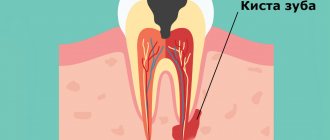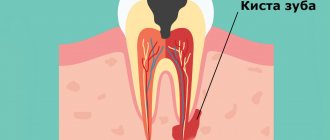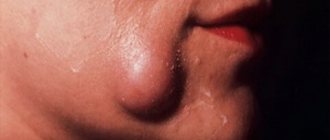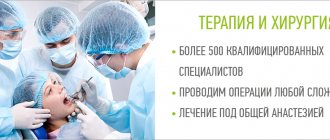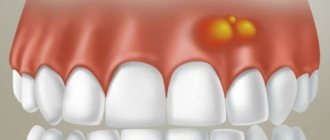Author:
- Yanova Natalya Yurievna
otorhinolaryngologist of the highest qualification category
5.00 (Votes: 1)
A cyst on the palatine tonsil is a benign formation in the form of a small spherical cavity filled with liquid or curdled contents, in the form of pus and mucus. It can be found both inside the tonsils and on their surface.
Tonsil function
The tonsil is a lymphoid tissue located in clusters in the pharynx. The tonsils are one of the organs of the immune system that protect the internal environment of the body from harmful influences. There are six tonsils in the human pharynx: two paired and two unpaired; together they form the so-called Pirogov-Waldeyer protective ring. The palatine tonsils (popularly called tonsils) are located closest to the entrance of the pharynx, and these tonsils suffer more often than others. The lymphoid tissue of the tonsils supports general and local immunity. Lymphocytes mature in it and antibodies are produced.
The palatine tonsils play a vital role. They are the largest and differ in their structural features. Upon careful examination, it is clear that the surface has depressions or lacunae, smoothly turning into crypts or deep folds lined with mucous membrane. Only the lateral surfaces are covered with a capsule of connective tissue, and all the rest are in contact with everything that enters the pharynx.
At CELT you can consult an otorhinolaryngologist.
- Initial consultation – 3,000
- Repeated consultation – 2,000
Make an appointment
Causes of dental cysts in children
Most parents do not seriously care about the health of their children’s teeth until they replace their baby teeth with permanent ones, arguing that the baby teeth will fall out anyway. This opinion is wrong - it is quite possible for a cyst to appear on a child’s baby tooth.
If caries has progressed to pulpitis, and then to periodontitis, then such a tooth becomes a source of infection, and the body, in order to stop its spread, turns on self-defense. To do this, it forms, most often at the root of the tooth, a protective bubble, or granuloma, which then transforms into a jaw cyst.
But not only advanced dental diseases can cause the formation of a tooth root cyst. Any injury, from cracking nuts to a blow to the jaw, can trigger the appearance of a dental cyst in a child. Those parents whose children are young hockey players or boxers need to be especially careful.
Also, if the treatment of pulpitis is poorly carried out, the infection will reach the roots through the canals of the tooth, as a result of which a rare type of dental cyst in children may occur - follicular, which occurs only in 6% of cases. The only thing you can wish for in such circumstances is to approach the choice of clinic and doctor competently and with all seriousness, otherwise your teeth will have to be constantly re-treated.
In addition, there is such a thing as an eruption cyst. It occurs several weeks before the appearance of a new baby or molar tooth. Teething cysts in children can be caused by infection, trauma, caries, or dental abnormalities.
Photo of eruption cyst in children
Classification
Experts distinguish two types of tonsil cysts:
- Retention - formed after blockage of the ducts of the glands of lymphoid tissue, have a classic round shape, a thin capsule, filled with serous or purulent secretion. After emptying (evacuation of contents or spontaneous breakthrough), they are filled again.
- Dermoid or congenital - formed during intrauterine development, inclusions of embryonic tissue are always found in them. These true tumors, caused by genetic causes or harm suffered by the mother during pregnancy, are very rare. The capsule is usually dense and the contents are viscous.
Causes of retention cysts
The reasons for the formation of cysts are varied, but more often than others, factors such as:
- chronic inflammation of the tonsils and pharynx with periodic exacerbations - tonsillitis, pharyngitis;
- autoimmune diseases accompanied by the production of a large number of lymphocytes;
- smoking, especially tobacco with a high tar content;
- injuries, including the habit of swallowing small bones;
- hormonal imbalance;
- occupational hazards, inhalation of aggressive aerosols;
- decreased immunity, especially local.
The formation of a cyst is caused by impaired drainage of the mucous lacunae of the tonsils against the background of the inflammatory process.
Prevention is the best cure
You can detect a cyst in children in the early stages of formation on an x-ray, which is recommended to be taken every six months if the child has diseases such as chronic pulpitis or periodontitis. Cysts are most likely to appear in children aged 7 to 12 years, during the period when baby teeth are replaced by permanent teeth. The cyst forms mainly in the area of the first molars, most often on the lower jaw.
The child must be taught regular, and most importantly, high-quality oral hygiene. If you don’t do this and don’t take your child to the dentist, the consequences can be disastrous. It is also worth taking note of the following: firstly, it is possible and necessary to treat pulpitis and caries of baby teeth; secondly, severely affected by caries is an indication for the removal of a baby tooth, which should be carried out in a timely manner, otherwise they will become a source of infection and subsequently provoke the appearance of a cyst.
You, as a parent and person responsible for the health of your children, must monitor the condition of the entire oral cavity from the first erupted tooth of your child. Remember: the visible part is only 40% of the entire tooth, so you should not assume that its healthy appearance indicates the health of the entire tooth. Don’t forget about going to pediatric dentistry - any disease in the early stages can be treated much easier and more effectively.
Manifestations of tonsil cysts
Symptoms of having a palatal cyst depend on its size and location. Cysts up to 1 cm in size usually do not manifest themselves, are invisible and painless. People, as a rule, do not even suspect their existence. Cysts can be discovered accidentally during routine examinations by an otolaryngologist.
You can suspect the presence of a cyst in the tonsil if you have bad breath with healthy teeth and normally functioning digestive organs. The smell comes from food particles that become trapped in the area of the cyst and begin to decompose there. As the size of the cyst increases, a person may experience the following symptoms:
- feeling of constant presence of a foreign body in the throat;
- sore throat or discomfort;
- difficulty and mild pain when swallowing solid food;
- hoarseness of voice.
Young children may begin to choke on food. If the cyst grows towards the pharynx, then a feeling of lack of air may occur, which is especially pronounced in children whose larynx is small. The existence of the cyst itself maintains chronic inflammation. The cyst excludes areas of the tonsil from immune protection.
Features of anterior tooth cyst
A cyst on the root of a front tooth as a disease is not particularly different from other types of cysts. It is a purulent formation formed in the root area. A cyst appears when the body tries to prevent the spread of pathogenic microbes from the external environment into the body. If measures are not taken in time, the pus bubble will constantly grow and risks reaching the paranasal sinuses, provoking tooth loss and the development of chronic sinusitis.
The main difference between a cyst above the front tooth is dictated by the increased strength of the teeth in the frontal part of the jaw, which in turn affects the volume of gum tissue. For this reason, there is significantly less space for localization and growth of the formation than in other places, so it tends to quickly come out. As a result, it is the cyst on the root of the front tooth that often develops into such an unpleasant stage as a fistula - a pathological canal in the gum.
Another feature: only a cyst of the front teeth can form due to inflammation of the maxillary sinus mucosa. Formations in other parts of the jaw, as a rule, arise due to injuries or incorrect actions of the dentist.
Diagnosis of a cyst
As a rule, detecting a cyst does not cause any particular difficulties, since the pharynx can be clearly seen even with the help of a backlit frontal mirror. The main thing is to contact an otolaryngologist for examination. ENT doctors use various instruments during examination - spatulas, elevators, and, if necessary, endoscopes.
The cyst is determined in different parts of the tonsils, on the surface or in the depths. It has the appearance of an opaque round formation, similar to a ball, whitish in color, elastic and mobile. There may be no signs of inflammation of surrounding tissues.
You cannot touch or put pressure on the cyst yourself - it can burst, and its contents are unknown. At best, the purulent contents will enter the stomach, and at worst, it will spread to other organs.
The doctor examines cysts larger than 1 cm very carefully, without damaging the surrounding tissues, trying not to touch the capsule.
Diagnosis of a cyst includes puncture (puncture and removal of contents). If necessary, the resulting material is examined in the laboratory to understand the nature of the disease. If a malignant process is suspected or blood is leaking from a cyst, treatment begins immediately, without waiting for the end of the examination.
Depending on age, general condition and concomitant diseases, the doctor may prescribe other clinical tests. The blood coagulation system, the functioning of the heart and lungs are required to be examined.
Surgical intervention (opening a tonsil cyst)
In cases where drug treatment is unsuccessful or when the patient experiences obvious, persistent symptoms, the doctor recommends surgical intervention, which helps prevent relapses in the future.
Before opening the cyst, the otolaryngologist performs local application (irrigation, lubrication) anesthesia, opens the cyst with a scalpel and evacuates the contents. After the intervention, the doctor treats the site of the process with antibacterial drugs and prescribes antiseptic therapy.
If necessary, upon completion of the intervention, the otolaryngologist can take the contents of the cyst for analysis or material for histological examination.
If repeated cystic formations occur, the cyst refills with contents, then the most effective method is considered to be surgical intervention, i.e. complete removal of the cyst with its membranes.
Treatment of palatal cysts
Tonsil removal
- Cost: 75,000 - 105,000 rubles.
- Duration: 30-40 minutes
- Hospitalization: 1-2 days in hospital
More details
Treatment of cysts is determined by many factors, primarily the size of the cyst, its location, growth rate and the age of the patient. At first, they always try to carry out a high-quality course of conservative treatment, especially anti-inflammatory treatment. Treatment is carried out both general and local.
The radical and best way to treat cysts is surgery, which can be performed in different ways. Small cysts located superficially are removed along with the capsule. After this, a slight scar remains on the tonsil, which soon resolves.
The operation is performed under local anesthesia, the patient does not feel anything. In most cases, the intervention is performed on an outpatient basis, and the person goes home the same day.
A cyst of significant size, especially one located deeply, is removed along with part of the tonsil. If there are several cysts or the location is such that it is impossible to get to them, the tonsil is removed completely and a tonsillectomy is performed.
Treatment methods
Conservative treatment:
- washing the tonsils;
- inhalation;
- rinsing;
- ultrasonic influence;
- laser therapy.
These procedures cleanse the tonsils, increase blood circulation, have an anti-inflammatory and antiseptic effect, which has a positive effect on the recovery process of the tonsils and their proper functioning.
If conservative methods do not produce results, then surgical treatment is resorted to.
Prevention of palatal cysts
It is important to understand that a cyst is usually formed as a result of a long-term inflammatory process. Carrying a bag of pus in the throat is extremely harmful; it is a source of chronic infection. Microbes have access to the bloodstream; if the body is weakened, this can lead to diseases of the heart, joints and kidneys.
ENT doctors at CELT have extensive practical experience in treating tonsil cysts. Specialists are ready to help people of all ages, including children, as well as those who have unsuccessfully tried treatment in other clinics. The main thing is to cooperate with your doctor to complete treatment until complete recovery. You can safely contact our clinic with this problem.
How is a front tooth cyst removed?
What to do with a front tooth cyst when therapeutic methods have not brought any effect? In such a situation, surgical removal is indicated. Since the front teeth have only one root, it will not be possible to get rid of the affected half - the aesthetics will be affected, and most importantly, the problematic tooth will soon break and will have to be removed.
The most popular and adequate way to remove a front tooth cyst is cystectomy. It is most appropriate on the front teeth, since it allows you to gain access to the cystic cavity without much difficulty. Under local anesthesia, damaged gingival and dental tissues are removed, and resection is performed (cutting off the root apex). After the operation, the tooth continues to function fully. There is a 100% guarantee of recovery with this treatment.
Despite the fact that the cyst initially functions as a protective mechanism, it works “for good” only up to a certain point. Without proper attention, the disease can lead to serious health problems. And in the case of a front tooth cyst, you need to go to a specialist immediately, since its development, due to the structural features of the front teeth, occurs much faster. To maintain dental health, make it a rule to visit a specialist twice a year - a cyst does not appear suddenly, it grows and forms over a long time, so regular examination will help stop the pathological process. If the symptoms of a front tooth cyst have already appeared, under no circumstances should you get carried away with painkillers or self-medication. The sooner you contact a professional, the easier and more successfully you will be able to get rid of the disease.
Our services in otorhinolaryngology
The administration of CELT JSC regularly updates the price list posted on the clinic’s website. However, in order to avoid possible misunderstandings, we ask you to clarify the cost of services by phone: +7
| Service name | Price in rubles |
| Taking ENT smears | 600 |
| Videoendoscopy of the upper respiratory tract | 2 400 |
| Radio wave removal of skin (mucous) neoplasms of ENT organs | 4 000 |
All services
Make an appointment through the application or by calling +7 +7 We work every day:
- Monday—Friday: 8.00—20.00
- Saturday: 8.00–18.00
- Sunday is a day off
The nearest metro and MCC stations to the clinic:
- Highway of Enthusiasts or Perovo
- Partisan
- Enthusiast Highway
Driving directions

